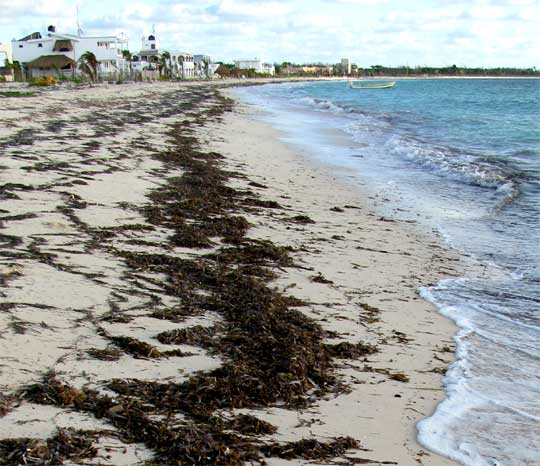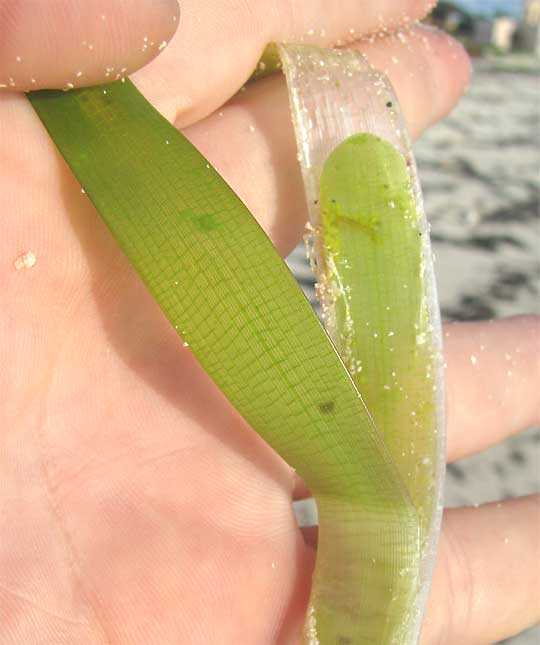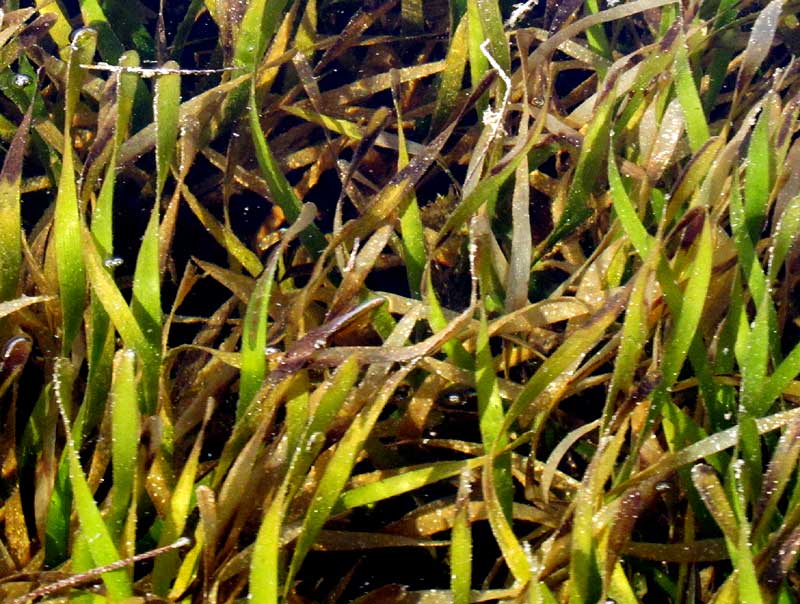Excerpts from Jim Conrad's
Naturalist Newsletter
from the December 1, 2008 Newsletter written at Mayan Beach Garden Resort 20 kms north of Mahahual; Caribbean coastal beach and mangroves, ~N18.89°, ~W87.64°, Quintana Roo state, MÉXICO
TURTLEGRASS
I've not done much naturalizing in coastal zones so I'm a green student here, hardly knowing where to begin. On my first day here I decided to figure out what the waves were heaping up on the beach, as shown below:

My first guess was that it was Kelp, simply because I'd heard of Kelp and knew that it gets heaped up on beaches. As you can see, nearly all the unknown plant is dead and brown, but also there were a few green sprouts in it, one being shown below:

Kelp is an alga, but this plant definitely shows cellular structure of a kind I don't think algae would have. Here I can browse the web so I did just that, searching on the "sea grass." I came up with SeagrassWatch.Org -- a whole site dedicated to sea grasses, and with a special page for sea grass identification.
That site seems to be in Australia, where I'd expect different species to occur, but their ID page still enabled me to decide that our beach-heaped plant probably is a member of the genus Thalassia. Scientific literature on the Web refers to vast sea- beds of THALASSIA TESTUDINUM just off the eastern Yucatán shore, and the pictures I find of that species look like mine, so I'm betting that that's what I have, despite having no flowers or fruits. It's certainly a "seagrass," since that's a generic name for various grasslike aquatic species. And it's probably "Turtle Grass," the name often applied to Thalassia testudinum.
There {used to be} a wonderful shot showing a sea turtle grazing on Thalassia testudinum at http://www.ceakumal.org/images/turteating.jpg.
That site also touches on Thalassia testudinum's ecological value. I read that the grasses develop root systems and rhizomes below the sediment that help to stabilize the sand, enhancing the transparency of the water. Seagrass is particularly important as refuge for small fish and other marine species, serving as feeding and nursery sites for a diversity of fish species, crustaceans, mollusks, manatees and turtles, such as the green turtle (Chelonia mydas).
I also read that Thalassia testudinum "prairies" are largest and thickest where underground rivers from inland Yucatán release their waters offshore.
What a wonderful plant! I feel as I did the first time I met Big Bluestem Grass, the emblematic grass of North America's great prairie biome.
from the June 21, 2015 Newsletter issued from Río Lagartos, on the Yucatan Peninsula's northern coast (~N21.60°, ~W88.16°), Yucatán state, MÉXICO
BEDS OF TURTLEGRASS
With the rains, the estuary's waters have changed drastically, often in surprising ways. One way is that in some places the water is especially clear, enabling submerged organisms to be seen better than before. A view of an aquatic plant in about a foot of water is shown below:

That's one of the four main "sea grasses" in this region, Turtlegrass, THALASSIA TESTUDINUM. As with the other sea grasses, Turtlegrass isn't really a grass -- not a member of the Grass Family. It's a monocot, like grasses, lilies, orchids and such, though, so it has flowers, which I hope someday to see.
In our area other sea grass species appear to contribute most to the brown masses that wash up on the Gulf's beaches. In such deposits some Turtlegrass can usually be found, and sometimes there's a lot of it -- it depends on currents, wind and other variables.
Gradually the importance of seagrass in general is being understood by the general public, as more and more property owners who "clean away the seagrass" find their beaches washing away and property threatened. Even seagrass washed up on beaches is important to local wildlife and provides a buffer to incoming waves that erode naked sand.